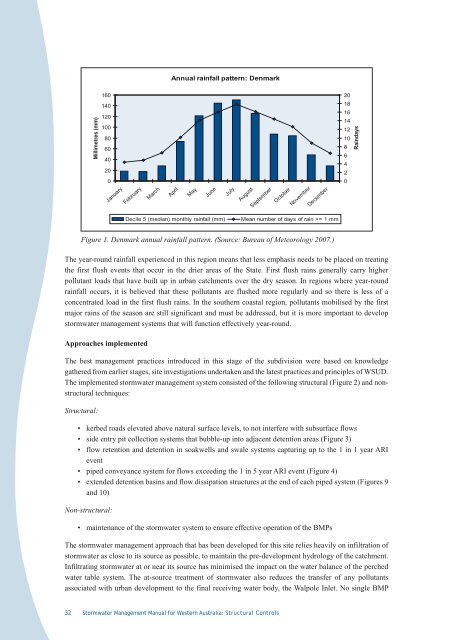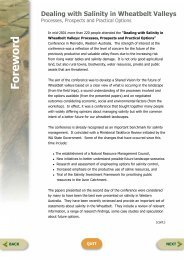9Structural Controls - Department of Water - The Western Australian ...
9Structural Controls - Department of Water - The Western Australian ...
9Structural Controls - Department of Water - The Western Australian ...
You also want an ePaper? Increase the reach of your titles
YUMPU automatically turns print PDFs into web optimized ePapers that Google loves.
Millimetres (mm)<br />
160<br />
140<br />
120<br />
100<br />
80<br />
60<br />
40<br />
20<br />
0<br />
January<br />
February<br />
March<br />
Annual rainfall pattern: Denmark<br />
April<br />
32 Stormwater Management Manual for <strong>Western</strong> Australia: Structural <strong>Controls</strong><br />
May<br />
June<br />
July<br />
August<br />
September<br />
October<br />
November<br />
December<br />
Decile 5 (median) monthly rainfall (mm) Mean number <strong>of</strong> days <strong>of</strong> rain >= 1 mm<br />
Figure 1. Denmark annual rainfall pattern. (Source: Bureau <strong>of</strong> Meteorology 2007.)<br />
<strong>The</strong> year-round rainfall experienced in this region means that less emphasis needs to be placed on treating<br />
the first flush events that occur in the drier areas <strong>of</strong> the State. First flush rains generally carry higher<br />
pollutant loads that have built up in urban catchments over the dry season. In regions where year-round<br />
rainfall occurs, it is believed that these pollutants are flushed more regularly and so there is less <strong>of</strong> a<br />
concentrated load in the first flush rains. In the southern coastal region, pollutants mobilised by the first<br />
major rains <strong>of</strong> the season are still significant and must be addressed, but it is more important to develop<br />
stormwater management systems that will function effectively year-round.<br />
Approaches implemented<br />
<strong>The</strong> best management practices introduced in this stage <strong>of</strong> the subdivision were based on knowledge<br />
gathered from earlier stages, site investigations undertaken and the latest practices and principles <strong>of</strong> WSUD.<br />
<strong>The</strong> implemented stormwater management system consisted <strong>of</strong> the following structural (Figure 2) and nonstructural<br />
techniques:<br />
Structural:<br />
• kerbed roads elevated above natural surface levels, to not interfere with subsurface flows<br />
• side entry pit collection systems that bubble-up into adjacent detention areas (Figure 3)<br />
• flow retention and detention in soakwells and swale systems capturing up to the 1 in 1 year ARI<br />
event<br />
• piped conveyance system for flows exceeding the 1 in 5 year ARI event (Figure 4)<br />
• extended detention basins and flow dissipation structures at the end <strong>of</strong> each piped system (Figures 9<br />
and 10)<br />
Non-structural:<br />
• maintenance <strong>of</strong> the stormwater system to ensure effective operation <strong>of</strong> the BMPs<br />
<strong>The</strong> stormwater management approach that has been developed for this site relies heavily on infiltration <strong>of</strong><br />
stormwater as close to its source as possible, to maintain the pre-development hydrology <strong>of</strong> the catchment.<br />
Infiltrating stormwater at or near its source has minimised the impact on the water balance <strong>of</strong> the perched<br />
water table system. <strong>The</strong> at-source treatment <strong>of</strong> stormwater also reduces the transfer <strong>of</strong> any pollutants<br />
associated with urban development to the final receiving water body, the Walpole Inlet. No single BMP<br />
20<br />
18<br />
16<br />
14<br />
12<br />
10<br />
8<br />
6<br />
4<br />
2<br />
0<br />
Raindays













